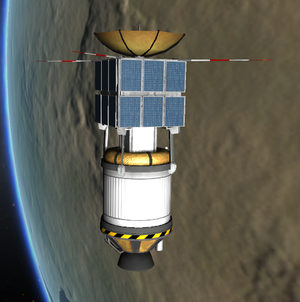Difference between revisions of "Z-MAP Satellite Launch Kit"
m (*renamed;) |
m (→Launcher: *wording;) |
||
| Line 5: | Line 5: | ||
== Launcher == | == Launcher == | ||
| − | The launcher has a very high [[thrust-to-weight ratio]] of 3.4 with all three engines running at 100 % throttle. Because of the high acceleration the terminal velocity is exceeded very fast lowering the efficiency. Another staging order would | + | The launcher has a very high [[thrust-to-weight ratio]] of 3.4 with all three engines running at 100 % throttle. Because of the high acceleration the terminal velocity is exceeded very fast lowering the efficiency. Another staging order would use only the [[RT-10 Solid Fuel Booster|booster]] until they run out after 29 seconds and switching to the [[liquid fuel engine]] then. |
Usually it is possible to reach orbit with the boosters and the first stage. To avoid debris the first stage should be dropped earlier and then finishing orbit with the second stage. This stage has also its own [[Probodobodyne QBE]] command module allowing deorbiting this stage after placing the payload in the targeted orbit. | Usually it is possible to reach orbit with the boosters and the first stage. To avoid debris the first stage should be dropped earlier and then finishing orbit with the second stage. This stage has also its own [[Probodobodyne QBE]] command module allowing deorbiting this stage after placing the payload in the targeted orbit. | ||
Revision as of 15:58, 26 July 2013


The Z-MAP Satellite Launch Kit (prior to 0.21 Z-MAP Satellite) is a stock rocket capable of bringing a small communication satellite into orbit. It consists of four stages with the last stage as the payload. The complete craft has a mass of 20.98 t with 78 parts, including two TT18-A Launch Stability Enhancers.
Launcher
The launcher has a very high thrust-to-weight ratio of 3.4 with all three engines running at 100 % throttle. Because of the high acceleration the terminal velocity is exceeded very fast lowering the efficiency. Another staging order would use only the booster until they run out after 29 seconds and switching to the liquid fuel engine then.
Usually it is possible to reach orbit with the boosters and the first stage. To avoid debris the first stage should be dropped earlier and then finishing orbit with the second stage. This stage has also its own Probodobodyne QBE command module allowing deorbiting this stage after placing the payload in the targeted orbit.
The launcher is capable of bringing the satellite into a synchronous orbit around Kerbin and then deorbiting the second stage back to Kerbin.
Satellite
The payload is a small 1.84 t heavy cubic communication satellite. It has four Communotron 16 on each corner of the front surface and one Communotron 88-88 placed directly on it. On each side except front and aft are six OX-STAT Photovoltaic Panels mounted. In the cube, on the other side of the Communotron 88-88, are the Probodobodyne OKTO2 command module, Oscar-B Fuel Tank and LV-1 Liquid Fuel Engine. To support the structure on each corner are four Cubic Octagonal Struts stacked on each other.
As there is a battery missing the only electronic storage are the 5 E in the command module, which isn't enough to operate the satellite in Kerbin's shadow.
Specifications
| 2× Booster | Stage 1 | Stage 2 | Stage 3 (Payload) | |
|---|---|---|---|---|
| Engine | RT-10 Solid Fuel Booster | LV-T45 Liquid Fuel Engine | LV-909 Liquid Fuel Engine | LV-1 Liquid Fuel Engine |
| Diameter | Small | Small | Small | Small |
| Mass (t) | 3.80 | 10.63 | 1.86 | 0.70 |
| Burn time (s) | 29 [Note 1] | 125.6 - 145.2 [Note 1][Note 2] | 84.8 | 127.4 |
- ↑ 1.0 1.1 All engines of the booster and first stage ignite at the same time.
- ↑ Maximum and minimum are for vacuum and atmospheric flight only; an ascend will have a value in between.
Possible uses
The launcher can bring other payload into a Kerbin orbit like the Ion-Powered Space Probe. As the thrust-to-weight ratio is very high it is also possible to bring heavier payloads in a low orbit.